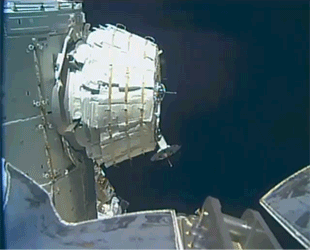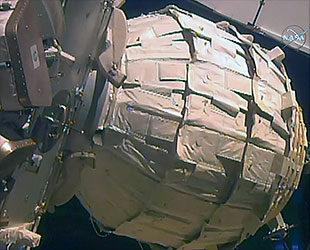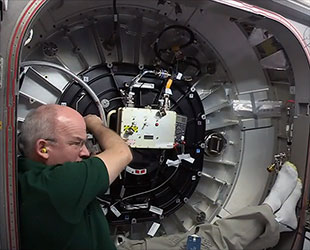May 28, 2016 — The International Space Station grew a room bigger — and gained a bigger room — on Saturday (May 28) with the inflation of an experimental habitat.
The Bigelow Expandable Activity Module, or BEAM, was slowly deployed to its full size using the space station's air supply to grow the fabric-constructed room to five times its deflated, compact volume. The successful inflation was the first milestone in a two-year test of the BEAM to evaluate the module's design for future orbiting outposts and deep space vehicles.
"We are declaring manual inflation complete at this point," radioed NASA astronaut Jessica Meir, serving as CapCom in Mission Control Houston, at 3:10 p.m. CDT (2010 GMT).
Jeff Williams, a flight engineer on the station's Expedition 47 crew, led the on-orbit operations to manually inflate the BEAM, slowly feeding air from the Tranquility node into the module using a small hand-controlled valve. When he was done, the BEAM had grown from its compacted 7 feet to 13 feet long (2.1 to 7 meters) and expanded from almost 8 feet to 10.5 feet in diameter (2.4 to 3.2 m).

Time-lapse showing the BEAM's inflation. (NASA TV/collectSPACE) |
The full inflation on Saturday came on NASA's second try to expand the BEAM, which was built by Las Vegas-based Bigelow Aerospace. On Thursday, the process was halted after Williams measured rising pressure levels without the module appearing to grow beyond a few inches.
Letting the BEAM sit for a night, flight controllers noticed that the module eventually did settle out to a slightly larger size and so chose to depressurize BEAM and try again.
The BEAM was launched to the station packed inside the unpressurized trunk of a SpaceX Dragon cargo spacecraft that arrived and berthed to the orbiting complex on April 10. Flight controllers in NASA's Mission Control in Houston then used the Canadarm2 robotic arm to install the BEAM on the aft port of the Tranquility node six days later.
Williams began the five step procedure to expand BEAM on Thursday, closing vent valves and releasing four straps that held the expandable module in its compact form for its launch.
On Saturday, the inflation began at 8:04 a.m. CDT (0104 GMT), with Williams following directions by Meir as to how much air to pump into module at a time. The first fill lasted 22 seconds, followed by bursts that ranged from just one second to a final fill of 30 seconds long.

The BEAM is seen fully-expanded on the space station. (NASA TV) |
As the BEAM grew, Williams reported hearing a popping sound, signaling the release of rip stop straps and stitches in the module's fabric construction.
"It sounds sort of like when popcorn in a frying pan starts up," radioed Williams.
NASA's conservative approach to inflating the module was to avoid the BEAM's aft bulkhead moving away too quickly from the station and then jerking back when it reached the module's full length, which would have imparted stresses on the interface between the BEAM and the station.
"We recognize that BEAM is a first of-its-kind spacecraft, and we are in full support of safety being the number one priority," Bigelow Aerospace said in a statement.
Ultimately, it took 25 bursts of air, totaling two minutes and 27 seconds long, to expand BEAM 67 inches (1.7 meters) out from where it started.

Expedition 47 flight engineer Jeff Williams sits at the hatchway of the BEAM, feeding air into the module through a valve. (NASA TV) |
With the BEAM at its full size, Williams switched from the station's air supply to the module's own internal air tanks to bring it up to the same pressurization (14.7 psi) as the rest of the space station.
Williams and his Expedition 47 crewmates will first ingress the BEAM after a week-long process of leak checks and other preparations. The module is empty inside, other than the sensors that will be used to monitor its status.
NASA plans to keep the hatch leading into BEAM closed for most of the next two years, only opening it for periodic inspections. This first test of a human-rated inflatable room will allow engineers to gauge how well the habitat protects against solar radiation, space debris and the temperatures of space.
Bigelow Aerospace, which is led by Robert Bigelow, owner of the Budget Suites of America chain of hotels, previously launched two free-flying inflatable modules, Genesis I and Genesis II, in 2006 and 2007 respectively. The company is now developing much larger expandable modules to serve as standalone space stations or as habitats for deep space vehicles.
